Problems of using nanomaterials and nanotechnology in construction. Рубрика в журнале - Nanotechnologies in Construction: A Scientific Internet-Journal
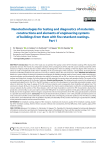
Статья научная
Introduction. The aim of the study was to optimize the quality control of fire retardant coatings (FRC) during their production and use. The results of a comparative analysis of the consequences of fires and their causes with the parameter of fire resistance of objects indicate that the number of fires and damage from them in buildings of the first degree of fire resistance is almost an order of magnitude smaller than in buildings of the second degree of fire resistance. Consequently, increasing the fire resistance of building materials and structures is the way to radically reduce fires and losses from them. Methods and materials. Based on a system analysis of existing fire protection technologies for building materials made of wood, metals, rubber and polymers, nanotechnologies were developed to determine the stability of samples with an FRC on the baro-electro-thermo-acoustic (BETA) analyzer and create their «images» for further diagnosis of their aging at the constructions and operation facility. The novelty of the study is protected by patents of the Russian Federation. Results and discussion. The obtained results consist in the refinement of computational algorithms for the FRC in the BETA analyzer, as well as in the development of a portable automated complex, which allows to determine the stage of «aging» of the FRC on these materials, and, consequently, their durability and update time. This conclusion is based, firstly, on the results of the development of a thermo-electro-dilatometer crucible for controlling liquid and viscous materials by the authors of the «float design», which will make it possible to control the FRC characteristics during their production, and secondly, to carry out express control after filling them in containers (polymer, metal, glass) without opening it and thirdly, due to the recognition of these «images» using thermo-electro-measurements of the FRC using special probes connected to a portable automated system. Conclusion. The results obtained make it possible to «arm» with portable automated systems not only construction and fire control authorities, but also manufacturers of emergency protection products. This will allow, according to the authors, to fundamentally solve the problems of quality and durability of FRC, but the main thing is to guarantee the stability of the protected materials and structures from them.
Бесплатно

Статья научная
Introduction. To determine the effectiveness of fire-retardant coatings (FRC), a system of methods for fire and high-temperature testing of fire-retardant materials and structures made of themis being used. However, there are no methods and means that could provide current effectiveness of fire protection, and existing methods cannot be applied to determine fire resistance of building structures with fire protection, they set only a group of the effectiveness of the flame retardants. Therefore, to assess the quality and durability of the FRC, in case they provide the parameters of thermal stability of the protected materials, structures and elements of the engineering systems of the objects, it was necessary to develop a quickmethod and a portable diagnostic complex of fire-retardant coatings (PDC FRC). Methods, models and tools. Based on a system analysis of the existing fire protection technologies for building materials from wood, metals, rubber and polymers, a rapid analysis methodology and PDC for thermo-electro-acoustic (TEA) sensing of FRCs using thermo-acoustic methods have been developed. That made it possible to determine thermal conductivity, the ultrasound speed and its absorption coefficient in the FRC, as well as to conduct a comparative analysis of the «FRC image» obtained on a BETA-analyzer with measured characteristics, based on which to calculate the time of its operability. Results and discussion. The PDC of FRC consists of a case with a laptop, with the immitance meter and a two-channel oscillographic attachment connected to the laptop, to the inputs of which a TEA-zonding unit is pressed, pressed to the FRC of the tested object (structure, material, cable), by thermal, electrical and acoustic signals from which the laptop software identifies the properties and stages of operational stability of the FRC. The PDC of the FRC and the proposed approach allowed us to synthesize a model of the Internet system of TEA - diagnosis of FRC and of the monitoring of the operational stability of the protected materials. The novelty of the study is protected by patents of the Russian Federation. Conclusion. The proposed approach and the PDC of the FRC made it possible to implement a quickanalysis of the FRC at the facility and to synthesize a model of the Internet system of TEA-diagnostics of FRC, which can become the basis of the national supervision system for the given area.
Бесплатно
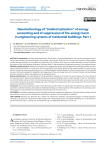
Статья научная
Introduction. Currently, both abroad and in Russia, there is a “general digitalization” not only of certain types of activities, but also of objects of the technosphere, for example, “smart houses”, “safe cities”, etc. However, the “creators” of these objects violated the main principle of automation of Academician V.M. Glushkov, which says: you cannot automate the mess! Therefore, the authors of this article made an attempt to “eliminate clutter” in the automation of engineering systems in the residential sector. Methods, models and tools. Based on the analysis of the engineering systems of multi-apartment residential buildings and individual residential buildings, as a result of the functioning of which not only the delivery of “life support benefits” is carried out, but also fire-energy and environmental damage occurs, a methodology for “intellectualization” of the accounting means for the supplied resources has been developed for diagnostics and suppression of fire and energy harm with the help of modern nanotechnology and, thus, prevention of fires and explosions in the residential sector. Results and discussion. The methodology of “intellectualization” is based on the results of a system analysis of the “functioning of the residential sector” (apartment buildings and individual residential buildings), which made it possible to “discover” the dialectical unity of benefits and harms from consumed energy resources (electricity, domestic gas, hot and cold water), as well as to carry out a systemic synthesis of nanotechnologies and means of “isolation and suppression” of fire and energy harm. The novelty of the research is protected by RF patents. Conclusion. The proposed approach allows “eliminating the disorder before the automation” of engineering systems of multiapartment residential buildings and individual residential buildings, by “intellectualizing” metering devices and optimizing nanotechnologies for suppressing fire and energy harm that brings socio-economic losses.
Бесплатно

Статья научная
Introduction. At present, both abroad and in Russia, accidents, fires and explosions in the engineering systems of multiapartment residential buildings and individual residential buildings have become more frequent. At the same time, the "creators" of automated systems for monitoring and accounting of energy resources (ASKUE) did not attend to the solution of the problems of safety of engineering systems, since their goals were exclusively commercial tasks – "digitalization" of energy consumption metering and detection of illegal consumption of such sources. Therefore, in this article, an attempt is made to "eliminate clutter" in the automation of engineering systems in the residential sector. Methods, models and tools. Based on the analysis of engineering systems of multi-apartment residential buildings and individual residential buildings, as a result of the functioning of which not only the delivery of life support resources (gas, cold and hot water, electricity, communications, etc.) is carried out, but also fire-energy and environmental harm occurs, a methodology has been developed for the "intellectualization" of the means of accounting for the supplied resources, for the purpose of diagnosing and suppressing fire-energy harm using modern nanotechnologies and, thus, preventing accidents, explosions and fires in the residential sector. Results and discussion. The methodology of "intellectualization" is based on the dialectical unity of benefits and harms from consumed energy resources (electricity, domestic gas, hot and cold water), as well as to carry out a systemic synthesis of nanotechnologies and means of "detection and suppression" of fire-energy harm. The novelty of the research is protected by RF patents. Conclusion. The proposed approach makes it possible to "eliminate the disorder before the automation" of engineering systems of multi-apartment residential buildings and individual residential houses, by "intellectualizing" metering devices and optimizing nanotechnologies for suppressing fire-energy harm which leads to socio-economic losses.
Бесплатно
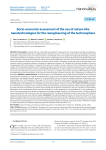
Статья научная
Introduction. Recently, the term “nature-like technologies” has appeared in the everyday life of scientists and politicians, which quite deservedly include the so-called alternative energy sources (sun, wind, heat). At the same time, despite the fact that installations using these sources are “seasonal” and low concentrated, their use is rapidly and haphazardly developing, and many economists and politicians mistakenly consider them as basics, misleading business. Based on the analysis of the epistemology of the origin of the term "nature-like technologies", this article shows the groundlessness, and even the harm of the rapid and unsystematic use of wind turbines. Evidence is given of the inconsistency of the "myths" that Nature cannot cope with the compensation of the economic activity of mankind, therefore, according to Academician Sergeyev S.M., President of the Russian Academy of Sciences, "reengineering of the technosphere" is required. At the same time, modern economic science is far from taking into account in his models of the assimilation potentials of the biosphere of regions and the functions of entropy production in them, preferring to model various “cycles and modes”, as well as calculate different “coefficients” in order to predict “crises and equilibria”, without taking into account the interaction nature and society. In this connection, a scientific and technical task about determinating the “place of reengineering of the technosphere” in the structure of the life support systems of society, and, consequently, to evaluate its effectiveness. Methods, models and tools. To solve the tasks set, it is proposed to use the “retro-forecast method” of socio-economic losses from the introduction of “natural nanotechnologies”, using as “tools” the method of “spatio-temporal analysis”, model of the Leontief-Ford and adaptive taxation systems of “harm production”, the use of which in solving the problems of fire and environmental safety in the "technospheres of the regions" of the South of Russia (in road transport infrastructures, in cities and towns, in buildings and structures), proved their adequacy to the processes under study and usefulness. Results and discussion. The results of modeling the costs of efficiency of "reengineering of the technosphere" in Russia, in particular individual residential buildings, and a retro-forecast of changes in socio-economic and environmental losses during the autonomy of their resource supply (electricity, water and heat) are presented. It is shown that the production of domestic innovations in this area (“Shukhov’s” wind turbines, atmospheric water condensation devices and electric heating) will allow stopping the “total gasification” of rural settlements, as well as more economically than abroad, to implement decentralized supply of resources in Russia more than 10 million individual houses and about 40 million country houses, thus determining the “true place of alternative energy” in the structure of the Russian systems of electricity, gas, water and heat supply. Conclusion. The proposed approach allows us to determine the place of the socalled renewable energy in the structure of resource supply systems for cities and rural settlements. At the same time, it is possible that the emergence of more productive design solutions of the proposed innovations in the field of wind energy and solar panels will expand the "autonomization" to low-rise and multi-apartment buildings in regional centers and workers' settlements, instead of a major restoration of centralized engineering systems with boiler houses and mini- CHP.
Бесплатно
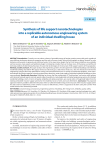
Статья научная
Introduction. Currently, one can witness a boom of renewable energy in foreign countries: zones with earth, coastal and even offshore wind power plants are emerging, and the roofs of houses, hotels, schools and hospitals are being "dressed" by solar batteries and by panels to generate electricity and water. At the same time, despite the fact that these installations are unreliable and rare sources, many experts and politicians begin to mistakenly consider them as the basic ones. All that poses a scientific and technical problem of determining the place of nature-like technologies in the structure of life support systems of the population. Methods, models and tools. The paper analyzes the engineering systems of multi-apartment residential buildings and individual residential buildings that deliver life support resources (electricity, gas, cold and hot water, etc.). But one should also note that the engineering systems often keep potential fire-energy and environmental harm. To resolve the mentioned problems, some nanotechnologies and Russian patents concerning autonomous electricity, water, heat supply of individual residential buildings on them were proposed. Results and discussion. Modeling has shown that the combination of "Shukhovskaya" and vortex wind turbines with domestic hydraulic panels and solar panels makes it possible to create duplicated and tripled engineering systems of individual residential buildings, which, in terms of quality, reliability and safety parameters, are several orders of magnitude higher than the existing centralized resource supply systems for the residential sector of cities and rural settlements. Conclusion. The proposed approach makes it possible to determine the place of the so-called renewable energy in the structure of the resource supply system for cities and rural settlements, and it remains to assess its effectiveness, which is supposed to be done using the Leontiev-Ford model and the retro-forecasting method.
Бесплатно
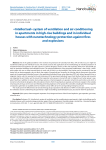
Статья научная
One of the global problems in the world is the protection of humanity from fires, 70% of which occur in high-rise residential buildings and individual houses. The article presents the application of the methodology of «intellectualization» of household electrical appliances for split systems to control dangerous factors of fire and explosion (DFFE) from household gas leaks in apartment buildings and individual houses. The principal difference of the proposed modification is that, firstly, a multisplit- system with two or three internal blocks is used, one of which is to be installed in the kitchen and is connected to the gas meter with an electromagnetic valve to block the supply of household gas. Secondly, the «kitchen block» disconnects the power supply in the apartment/individual house, in the apartment/individual house, when detecting DFFE with help of powerful triac or magnetic starter, which is mounted in the electrical panel of the apartment/individual house. And thirdly, a battery and converter are integrated in each indoor unit to ensure their operation when power is turned off, and to charge the unit when power is supplied. Fourthly, in addition to smoke, heat and gas sensors, a thermomagnetic air separator is built into each indoor unit, which is turned on when detects dangerous fire and explosion factors from the pumped air, separates and removes oxygen to the outside, returning only inert gas to the room and thereby preventing explosion or fire spread. The controller, including the thermomagnetic air separator, generates an audible alarm for residents and an SMS call to the corresponding emergency service. The results prove the effectiveness of nanotechnology of gas separation and detection of DFFE in multi-split-systems, not only for ventilation and air conditioning of apartments in high-rise buildings and individual houses, but also for their fire protection.
Бесплатно

